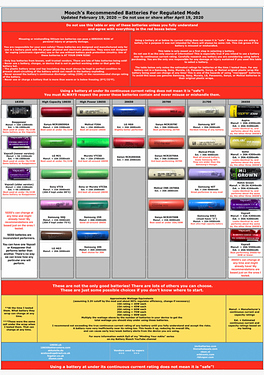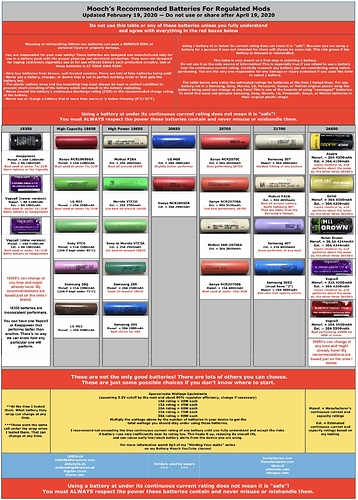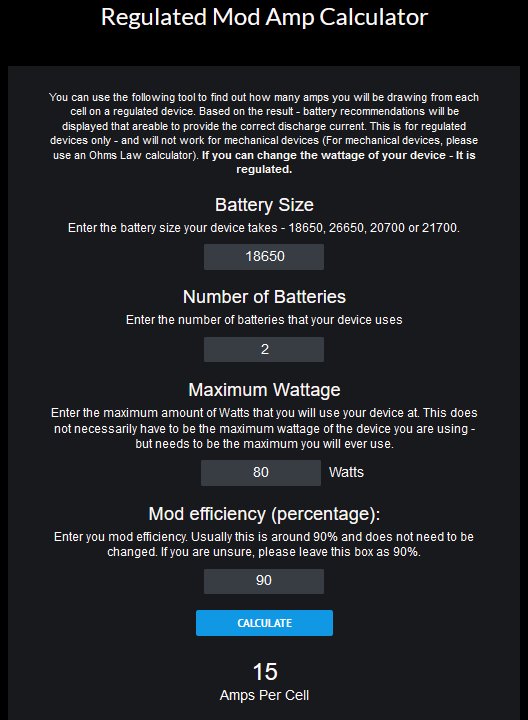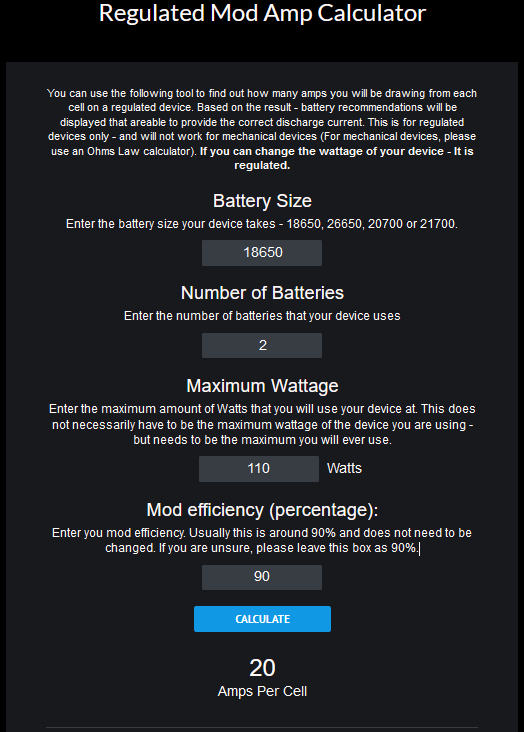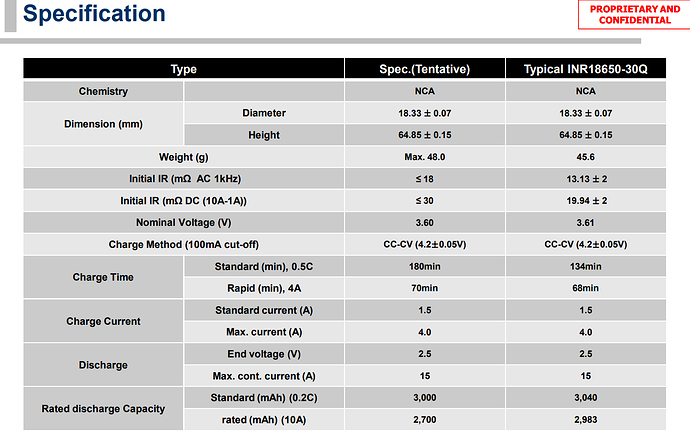Is it the Samsung VTC 5A
Recently purchased several of these similar (3500 mAh capacity, 10 Amps discharge) costing $3 each:
https://lygte-info.dk/review/batteries2012/LG%2018650%20MJ1%203500mAh%20(Green)%20UK.html
I use a ~1.0 Ohm single-coil at ~5.0 Watts (Current ~ 2.24 Amps). Not much, compared to many folks. Yet, it appears (not rigorously verified with my DC voltmeter, but un-explainable otherwise) that enough Voltage Sag takes place such that my Sigelei 30 W Minis (which use an archaic but lovable 30 Hz PWM system that also switches into “Bypass” if/when the PWN system fails to regulate sufficiently) seem “choked off”. (Thanfkully), less evident using my eLeaf Pico 25s and Vaporesso Swag II [which use more modern higher frequency schemes in their design, and (also) do not “switch into bypass mode”].
If one (just) looked at the Internal Resistance (by AC Impedance) specification (where these LG MJ1s are rated at 0.06 Ohm, as opposed to the 0.04 Ohm ratings of 30Qs and, I think 25Rs as well), the reality of untoward (varying by Mod design) operational limitations due to good old “Voltage Sag” would never become apparent. At continuous current draw greater than 2 Amps these (may) present problems
(On paper, anyway, and at 2 Amperes discharge), the MJ1 appears to best Samsung 30Q performance:
Widget at: http://lygte-info.dk/review/batteries2012/Common18650comparator.php
Unfortunately, my Sigelei 30W Minis do not agree (and Voltage Sag seems almost certainly the effect).
Note that unless device will function down to ~3.1 VDC voltage/cell (or so), “high capacity” means little.
Cool.  Now… Single coil or dual coil set up on the atomizer?
Now… Single coil or dual coil set up on the atomizer?
Second that! I just got some in today, and they are the best I have used thus far
P26As appear to have high current discharge capability. (Per this), see comparisons (at 5.0 Amps):
Sony does the VTC series.
This is so true. Graphs can tell 1 thing but real life experience may be something very different. That’s why these forums are a great way to exchange experience.
By the way, I actually own a couple of those 3500mah Fogstar batteries (the first ones I ever bought, I knew nothing) and they are pretty good when used correctly. I bought them for an Aspire MTL device and I’ve used them in a 3-battery mod using RDA’s/RTA’s vaping around 60-65W (so well within its limits). They last about as long between charges as the Sony VTC6’s (3000mah, 20A) or even the Samsung 30Q’s (3000mah, 20A) but the latter are MUCH safer.
When high capacity batteries are drained at max rate, they don’t last any longer than lower capacity batteries that are drained well below max rate. That is real life experience that I’ve never seen in any graph.
Glad you like them! 
I tend to keep up with the current recommended Mooch ratings on ECF.
https://www.e-cigarette-forum.com/blog-entry/moochs-recommended-batteries.7593/
https://www.e-cigarette-forum.com/attachments/49fa6133-d87a-4630-9fff-bcc3831185b1-jpeg.874743/
Trust the Mooch! 
BTW, the Samsung 30Q is (from what I can see) rated at a 15 Ampere continuous discharge current:
https://lygte-info.dk/review/batteries2012/Samsung%20INR18650-30Q%203000mAh%20(Pink)%20UK.html
I was reading a seemingly fairly impressive treatise regarding Lithium-Ion batteries, and it was stated that the higher the intended battery current capacity (in total mAH), the less “stable” is the design. This would follow - in that the (inner) wraps are constructed of thinner material in the higher capacity efforts, allowing for a higher probability of unintended “dendritic” electrical-short connections to form internally.
Having purchased no less than 10 of these little LG MJ1 pigs (at $3 each from the pompous jerks at IMR Batteries in a “closeout” sale), I am hoping that my limited to <2.5 Ampere continuous battery discharge currents, and conservative (500 mAH) charging regimens will allow me to get some useful duty out of these batteries without “safety incidents”. Experience any “incidents” with your “Fogstars” ?
I go by Mooch’s recommendation:
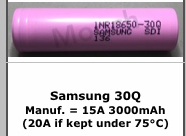
Usually, my batteries operate below 75C (and I stay mostly below or around 15A anyway).
As long as you have a 2 battery regulated mod, don’t go over 80W, or a 3 battery mod even better, you shouldn’t worry about the 30Q’s in any case.
Right. But the reason that I mentioned this is that you posted a 20 Ampere current rating for the 30Q:
![]()
Because that is Mooch’s test result, not the manufacturer’s specification (which uses the 75C clause in mind probably).
Up to 110W on 2 battery regulated devices, the Samsung 30Q’s will operate very happily. But that is not to say there aren’t any better quality batteries for this purpose. Just saying they’re a relative safe option and definitely good quality/price ratio for people pinching the pennies.
If you want my recommendation purely based on quality and safety, I will only say go for the Molicels P26As, if only that they’re the only manufacturer that says their batteries are OK for vaping.
The (only) Samsung generated specifications document that I have located states 15 Amperes Max:
Source: https://eu.nkon.nl/sk/k/30q.pdf
Uhuh, but Samsung also recommends NOT using its batteries for vaping 
So if you just go by their recommendation, why even think about them

Suit yourself there. I would myself strangely choose to consider Samsung’s published specifications.
![]()
Despite that lovely sentiment (as was enunciated by “The Mooch”, with the best of intentions), I myself was unable to locate any US-based retailer of Molicels batteries who would honor that. Do you know of (any) specific retailers (located anywhere in the world) selling Molicel batteries to consumers who do replace (such openly used by the consumer for “vaping” rituals) “defective units” ? Ever tried Molicels ?
What I mean exactly is: [1] Have you yourself purchased and tried-out Molicel batteries ?; and [2] Do you know of (any) retailer willing to replace defective Molicel batteries known to be used for “vaping” ?
I fail to see where this is leading. Batteries are “consumable” or nondurable products and unless it’s obvious there’s a manufacturing problem, you suck it up and replace it yourself when they wear out. AFAIK, batteries don’t fail on themselves but by user error or malfunctioning devices. And in the rare cases that there would be an issue with the battery itself, you still have nothing to say if the manufacturer’s recommending you not to use it for vaping.
And I respect that point of view. I’m not saying I don’t keep that in mind, but I also know that different manufacturers have different standards, ways of testing, marketing and so on. Why I trust Mooch is because he’s a vaper himself and tests different brands and models to the same standards with vaping in mind.
It’s because of people like him that you have good comparisons where you have a fair idea of what you’re dealing with when you’re purchasing your next set of batteries.
Right, and you (above) posted “The Mooch” himself rate the 30Q at a 15 Amperes continuous discharge current - after I pointed out that you (in likely “just a typo”) yourself stated a 20 Amperes continuous discharge current for the 30Q. Simple as that. I do not thus comprehend why the (Samsung) 15 Amp rating would be controversial ? The Samsung 30Q specifications document was published in 2014. ![]()
lol
I’m not disputing the 15A rating, just saying that’s the CDR above an operating temp of 75C as tested by “The Mooch”. Below 75C, which is I’d hope every vaper’s normal operating temp, it could be considered at 20A. If you want to play it safe and still see it as 15A no matter what, that’s perfectly fine. Better safe than sorry 

